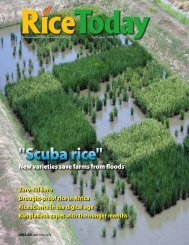How much water does rice need? - adron.sr
How much water does rice need? - adron.sr
How much water does rice need? - adron.sr
You also want an ePaper? Increase the reach of your titles
YUMPU automatically turns print PDFs into web optimized ePapers that Google loves.
Map 2. Distribution of rainfed lowland <strong>rice</strong> soil quality area in Asia. Each dot is colored to represent the assumed dominant soil class.and Vietnam (saline and acid-sulfatesoils); and in coastal regions ofBorneo, Sumatra, and New Guinea(acid-sulfate and organic soils)(Map 1A). Fertile soils withoutmajor constraints are relativelywidespread in India, Bangladesh,western Myanmar, Java, Cambodia,northern China, and Korea (Map 1B).Poor soils without major constraintsare frequent in eastern India, SriLanka, coastal lowlands of Borneoand Sumatra, and New Guinea (Map1C). Very poor soils with considerablesoil constraints are particularlycommon in the eastern parts ofMyanmar, most of Thailand, Laos,Vietnam, Malaysia, Borneo, Sumatra,and Cambodia (Map 1D). In India,very poor soils are mostly limited tothe west coast and to mountainou<strong>sr</strong>egions in the north and northeast.We overlaid the soil groups withthe distribution of rainfed lowland<strong>rice</strong> area (Map 2). 5,6,7 The resultsshow that only about one-third ofrainfed lowland <strong>rice</strong> is grown onrelatively fertile soils, slightly lessthan one-third grows on soils withlow indigenous soil fertility, andslightly more than one-third isproduced on soils with considerablesoil constraints often combined withvery low soil fertility. Rainfed lowland<strong>rice</strong> in Southeast Asia is <strong>much</strong> morelikely to be on poor soils with varioussoil constraints compared with Southand East Asia. About 7% of rainfed<strong>rice</strong> is grown on problem soils suchas acid-sulfate or saline soils.Soil quality is a major constraintcontributing to the low productivityof rainfed lowland <strong>rice</strong> ecosystems.<strong>How</strong>ever, spatial variation shouldnot be ignored: farmers growingrainfed lowland <strong>rice</strong> in Southeast Asiaare <strong>much</strong> more likely to encountervery poor soils with various soilconstraints than farmers in Southand East/Northeast Asia.Dr. Haefele, a soil scientist, andDr. Hijmans, a geographer, workat IRRI.5See The where and how of <strong>rice</strong> on pages 19-21 of Rice Today Vol. 6, No. 3.6This type of analysis is hampered by the spatial resolution of soil data. The digital soil map of the world was updated recently but it <strong>does</strong> notinclude detailed soil data that are available nationally, but even these data suffer from large variability within mapping units. In the future,this will probably be addressed by predictive spatial modeling of soil properties.7Soil characteristics can be strongly modified by local geomorpholgy and hydrology. Integration of soil characteristics with land properties suchas slope and climate is a next step we want to take in the characterization of Asia’s rainfed lowland <strong>rice</strong> ecosystems.Rice Today January-March 2009 31

















